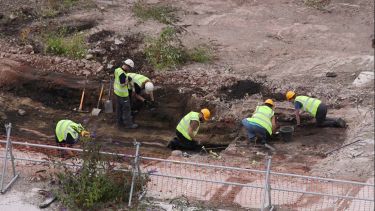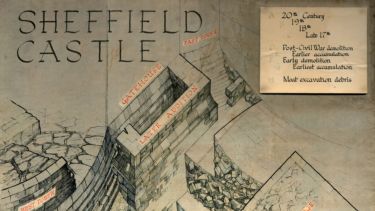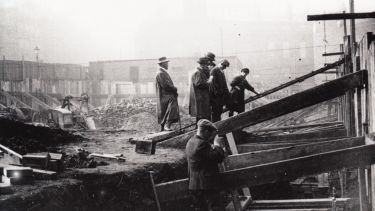Sheffield Castle: the story so far
Archaeologists from the University of Sheffield are working on a major project to recover and promote Sheffield Castle, a key element of the city’s forgotten medieval heritage.

Findings from the excavation, which involves several of our archaeology students and is being led by Sheffield-based Wessex Archaeology North, will inform a long-standing collaboration between the University of Sheffield, Sheffield City Council and the Friends of Sheffield Castle to inspire regeneration of the city’s Castlegate Quarter.
Ongoing work by the Department of Archaeology, in collaboration with the University's School of Architecture and Landscape, has revealed the history behind the castle. Our archaeologists have worked closely with the students from the School of Architecture to develop designs for use of the site to attract business, investment and tourism to the area.
Read the School of Architecture's blog on Revealing the Castle
A groundbreaking moment: uncovering Sheffield's castle
John Moreland, Professor of Medieval Archaeology, introduces Wessex Archaeology’s new excavations on the site of Sheffield Castle and the current Sheffield archaeology students digging there.
The history of Sheffield Castle
Sheffield is perhaps better known for its place in the Industrial Revolution as ‘Steel City’, but its roots lie in the medieval period, and are closely associated with the foundation of a castle in the late 11th or early 12th century, possibly by Roger de Busli, at the confluence of the rivers Don and Sheaf. The castle became one of the largest and most important in the north of England, and was rebuilt and developed by the de Lovetots through the 12th century and by the Furnivals in the 13th. By the 15th century, the castle had passed to the Earls of Shrewsbury. During the English Civil War, the castle was controlled by the Dukes of Norfolk, who sold the site for redevelopment through the late 17th and early 18th century. It became an area of slaughterhouses, metalwork and other trades.
Associated with the castle was an extensive deer park (on its eastern side) which had a lasting influence on the development of Sheffield in this area. The historic core of Sheffield developed in the streets to the west of the castle towards the parish church, now the Cathedral. The story of the castle has become closely associated with the site of an Anglo-Saxon hall, the story of Mary Queen of Scots, held here between 1570-84, and its destruction following the English Civil War. The cathedral, the Manor Lodge (the site of the hunting lodge), Lady’s Bridge and the Queen’s Head pub are prominent survivors of Sheffield’s medieval and early post-medieval past.
The castle was subject to two periods of archaeological investigation between 1929-1940 and 1958-1972. The results from the initial work by Leslie Armstrong and Joseph Himsworth were published in the Transactions of the Hunter Archaeological Society in 1930, but many of the later records by Himsworth remain unpublished. The second campaign of investigation by Leslie Butcher also remains unpublished. The Castlegate Archives Project was set up to bring the results of these earlier studies of Sheffield castle to publication. Through the work of the Castlegate Archives Project our understanding of the development of Sheffield Castle, its association with the town and deer park has been transformed.
The full archive of archaeological observations is being analysed and published by the Department of Archaeology at the University of Sheffield. The project is led by Professor John Moreland, Professor Dawn Hadley (the latter now at York) and Dr Gareth Dean. The work is being carried out in collaboration with Sheffield Museums, who hold the archives, Wessex Archaeology and independent specialists, Dr Chris Cumberpatch, Jane Young and Quita Mold. Reviews of the historical records were carried out by Dr Rachel Askew and Dr Alan Bryson.
The project has been funded by the University of Sheffield through The Pamela Staunton Bequest, the Academic in Residence Scheme (Faculty of Arts & Humanities) and the PVC Research Development Fund, with additional funding from the Society of Medieval Archaeology.
The project builds on earlier work on aspects of medieval and post-medieval Sheffield. Work on the Manor site was funded by The Higher Education Innovation Fund (HEFCE) and the AHRC funded the development of an app for Sheffield Lives: the birth of a city.
The main aim of the Castlegate Archive Project is to assess previous assumptions regarding the site based on the limited published evidence through a thorough reassessment of the excavation archive. Key themes the project hopes to address are:
- The origins and development of the castle
- The relationship between the castle and the town of Sheffield
- Evidence for the Civil War siege of the castle and subsequent redevelopment
- The process of archaeological investigation in the 1920s and 1950s
- The relationship between the archaeology of Sheffield Castle and urban regeneration
The project will create a digital archive and major new publication that will review the significance of the excavations and develop the narrative of our understanding of the castle within Sheffield and its surroundings. This will provide a crucial overview of the archaeological and historical evidence from the original heart of the city of Sheffield, vital to informing both people in the present and its regeneration in the future.



